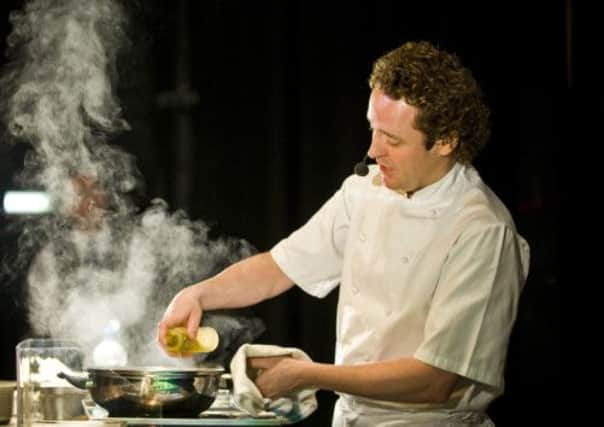Tom Kitchin: Great egg recipes


Basic sauces are some of the first things a cook should learn, and it’s generally thought that a good sauce can make a dish. It’s often referred to as the backbone of French cuisine but, in fact, most types of cuisine rely on flavoursome sauces to make good dishes great.
A few classic sauces will give you useful skills, and with a few twists, they can be used in a variety of dishes. It might seem easier to reach for a tin or a jar of sauce but, believe me, the taste you get won’t be anything like what you will achieve if you start from scratch. Making sauces doesn’t have to be time-consuming or complex. With some sauce recipes, you can also make up a big batch and store or freeze it.
Advertisement
Hide AdAdvertisement
Hide AdMayonnaise, vinaigrette, tomato sauce, béchamel and hollandaise sauce are the classics most people will know, and each of them can be very simple to make. White sauces are the basis for many recipes. Learn how to make a good hollandaise, and you’ll also be able to make numerous varieties of the white sauce. The hollandaise is the difference between a good eggs Benedict or eggs Florentine and a bad one, but it’s also an incredible accompaniment with the first seasonal asparagus, grilled vegetables, seasonal seafood – the list is endless.
A classic hollandaise sauce is made from an emulsion of egg yolks, vinegar and melted butter. Try to think of the sauce in those terms and you’ll begin to realise how simple it can be. These are also the essentials for béarnaise and mousseline sauces, so if you master this recipe, you’re on your way to mastering many more.
The trick with making hollandaise is in the temperature of the egg. You should heat it enough to get the thickness you need, but not so much that it congeals and curdles. Another key step is in the bain marie. This means heating the eggs in a bowl over a pan of simmering water. That helps make sure you keep the eggs away from direct heat – treating them much more delicately so the end result is perfect. You need to continuously whisk the ingredients together. It will take a little while to thicken the sauce but be patient and you’ll get there.
The final touch is a squeeze of lemon, which really cuts through the richness of the sauce and gives it freshness and balance.
Next time you’re even tempted to reach for the tin or the jar, remember just how delicious, fresh and flavoursome a homemade sauce can be. n
Hollandaise Sauce
• 4 egg yolks
• 250g clarified butter
• Juice of ½ lemon
• Salt
Method
Bring a saucepan of water to the boil. Put the egg yolk into a bowl that fits over the saucepan and add two tablespoons of water. Place the mixing bowl over the pan of simmering water and whisk until the egg yolks foam and then thicken.
Reduce the heat and cook the yolks until they have the consistency of cream. Using a spatula, keep scraping the sides of a bowl to keep the eggs from scrambling. When you can see the bottom of the bowl as you whisk, it is time to stop cooking.
Remove the bowl from the heat and whisk until the eggs have cooled and you are able to hold your hand against the bowl without discomfort. Put the bowl on top of a folded tea towel to keep it steady. Season to taste.
Advertisement
Hide AdAdvertisement
Hide AdTo make the clarified butter, gently melt the butter over the lowest possible temperature. The water and milk will separate and go to the bottom and the pure butter will be on top. Gently pour through a strainer and discard the white solids. Pour a thin stream of clarified butter into the eggs, whisking constantly until all the butter has been incorporated. Add the lemon juice, season and the sauce is ready to serve.
Eggs Florentine on toast
Serves 4
• 100ml white wine vinegar
• 4 quality eggs
• 4 slices crusty, fresh, sliced bread
• 400g spinach
• Splash olive oil
• Cracked black pepper
Method
Fill a tall, heavy-bottomed pan with water and bring to the boil. Add white wine vinegar, then crack your eggs into a teacup. At this point you can crack all four eggs into one cup as the protein will keep them separated. Take a spoon and create a whirlpool in your pot of boiling water, then tip the cup of eggs in gently. As the eggs hit the water, they will naturally separate.
Poach the eggs for one and a half to two minutes. You can use a spoon to tell if they are cooked by placing it in the pan then touching it with your finger to see if the eggs are at the right cooking temperature.
While the eggs are poaching, toast the bread.
Sweat down some spinach by heating a frying pan, then adding a dash of olive oil. Make sure you get the pan really hot before you add the spinach. Take the spinach out and squeeze off any excess water.
To serve
Take your toasted bread and add a layer of spinach. Place one poached egg on top, add cracked black pepper then pour over the hollandaise sauce. If it’s perfectly cooked, you’ll be able to cut through the yolk and watch it ooze on to the toast.